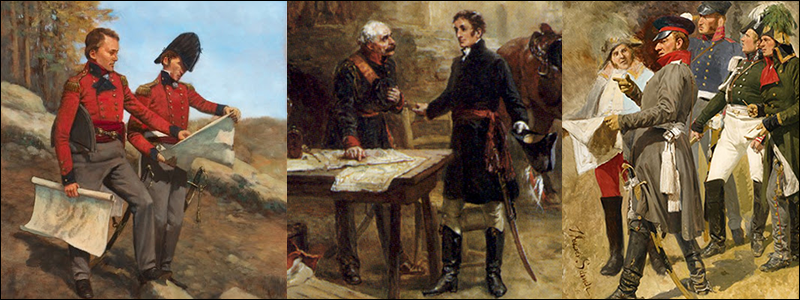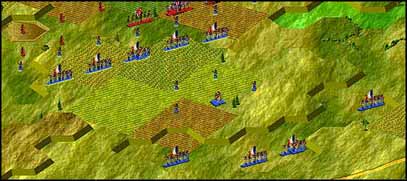|
Allied Training College (ATC) Coalition Library |
Lesson Two: Officers' Mess Introduction |
Chef de Bataillon Pomme de Voie, Commanding. Just listen-up!! - this is basic training. Your Marshal's Baton stays in the pack for now. Strive to keep your troops in good order - not disordered! The incessent rain and le Chef's gout keep us off the drill field today. Perhaps a little etiquette practiced with the officers will help you in re-Forming your disordered Units. Keeping your troops in Good Order means they march farther and shoot better. At the begining of every player turn each disordered unit is given a 'Command Check' ~ like an inspection before it can go 'on pass' don't you know - against a Command Rating of '1'. You need a die roll of '1' (or less) for each in order for it to Re-Form, that is return to Good Order. If it is within the Command Radius of its own Brigade (Regiment for you Prussians) Leader and he has passed his own command check, the die roll may be modified by adding a minus 1 thru as much as a minus 4 as passed down ~ as orders you might say ~ from the Army Leader. Now lads how that works is something they teach you in General Staff School before you are promoted General. Right now you need to concentrate on dispersing leaders so they can do their best to help Re-Form troops which have lost their Good Order - especially in the heat of battle. This picture shows a French Divisional Commader (the chap surrounded by skirmishers) who has both his Brigade Commanders easily within his 6-hex limit. The forward-deployed Brigade are highlighted in yellow and have their commander placed in the centre of their formation so all units are 'in command' ie within the leader`s 3-hex command radius. Note that even the skirmishers facing the enemy are all in command control in this example.
Now lads be sure not to forget the Division Artillery. To be sure, it seldom loses Good Order, but the Division Leader must attend to it if it is in a position where it is at risk. This is a good place to re-emphasise that not just any old leader will do; he has to be the officially assigned one. This is not just a parade you silly ass. You Prussians must remember that without the Brigade (Division) Leader within 4 hexes, the Zugeteilt Kavallerie will spend a lot of time resting in the woods waiting for that old number '1' to come up. Remember: at the next Officer's Mess, don't be the last on your feet for the toast 'To the Old Soldiers! They've saved many an officer's ass.' So, just in case you cannot understand 'in command' as told in English in your Players Guide?? Then I, a Frenchman shall have to say it to you! Each Leader - yes, even Blucher, Napoleon and Wellington - has a Command State! They are either 'In Command' or 'Out of Command' (Tut-tut, everyone must answer the call from nature, no?) At the beginning of each player turn a die is rolled for each friendly leader as his 'Command Check'. If the result is equal to or less than the leader's Command Rating (as shown in the unit list with A=6 thru F=1), he is In Command. If it is greater, he is... ahem... otherwise occupied. Now begins the great fun of a cascade downward of die roll modifiers which may eventually affect the re-ordering of disordered units.
Then my friends, we have to deal with the detachments. Ah, yes! That is the way my lady friends treat me, but that is not what we are speaking of. In some lofty way, the program may show certain leaders as 'detached'. Also leaders and units outside of their commander's radius are considered detached. If a 'detached' leader passes his 'Command Check', he may pass down his minus 1. Of course a 'detached' Disordered unit will Re-Form only on a die roll of '1' for its 'Command Check'. So now you see, a Frenchman can be of some help to you English speakers! [Written by J. P. - Scenario Design Centre (SDC)]
|
Site Designed Maintained by Scott Ludwig & Walt Moehle (Coalition Army Webmasters) © 2005-Present September 19, 2024 8:56 AM |

